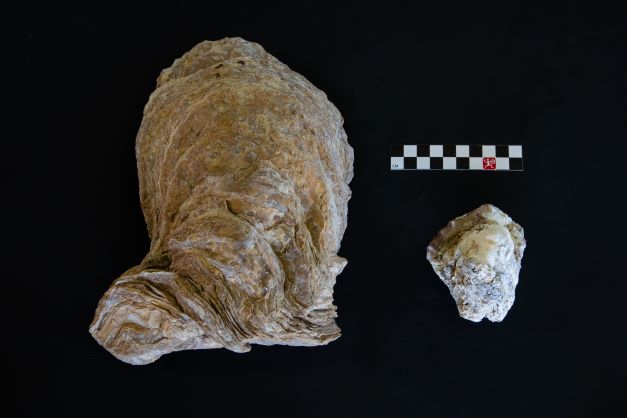Giant Oysters
GIANT OYSTERS
LOOKING LIKE SCIENCE FICTION CREATURES, MASSES OF GIGANTIC OYSTERS CAN BE FOUND IN REEF FORMATIONS IN STARR AND ZAPATA COUNTIES.
Common in Starr and Zapata Counties are deposits of fossilized oyster beds which formed in the shallow lagoons behind barrier islands, represented today by the Roma Sandstone.
The ancient sandy barrier had an adjacent shallow lagoon with shellfish beds much like those in present day Laguna Madre. Giant Eocene oysters some as large as 18 inches or 46 cm in length formed typical oyster “reefs” building mounds up to 2 meters or six feet in thickness over time. These oysters have the perfect name, Crassostrea gigantissima!
European settlers burned these fossilized oyster shells in the eighteenth, nineteenth, and early twentieth century to make mortar and plaster for houses constructed with Roma Sandstone blocks.
During the Eocene, a shallow coastal lagoon, comparable to today’s Laguna Madre, was found behind the barrier island delineated by the Roma Sandstone. Evidence for this intertidal lagoon includes the presence of oyster reefs throughout Zapata and Starr Counties. Most impressive among those are a few reef patches of the giant oyster, Crassostrea gigantissima. These reefs are also part of the Jackson Formation.
Listen to the English podcast of the Giant Oyster Shells
In the nineteenth and early twentieth century, the fossil giant oyster shells provided the raw material for the manufacture of lime which was used to make mortar and plaster for houses constructed with Roma Sandstone blocks. Kiln sites for burning lime were located along the banks of arroyos by the river.
Beds of broken shells are exposed on the shores of Falcon Lake State Park when the lake level is low.

Abundan en los condados de Starr y Zapata los depósitos de lechos fosilizados de conchas de ostras que se formaron en las lagunas saladas de poca profundidad ubicadas entre las islas de barrera y tierra firme, en el punto donde emplaza en la actualidad la zona de «Piedra arenisca de Roma», en la localidad homónima del Sur de Texas.
La antigua barra arenosa resguardaba una laguna salada y somera, poblada por lechos de moluscos muy similares a los que se encuentran hoy día en la Laguna Madre. Estos ostiones gigantes del Eoceno, que alcanzaban tamaños de hasta 45 centímetros de longitud, con el tiempo se agrupaban en formaciones similares a arrecifes o montículos submarinos de hasta dos metros de grosor. El nombre en latín de la especie hace honor a su tamaño: ¡«Cassostrea gigantissima»!
Desde el siglo XVIII y hasta principios del siglo XX, los colonos europeos calcinaban estas conchas fosilizadas para fabricar mortero y usarlo en la construcción de viviendas mediante bloques de lo que hoy se denomina «Arenisca de Roma».


